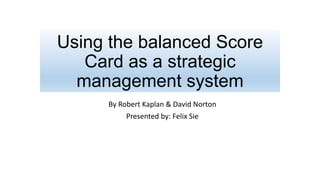Using the balanced_score_card
- 1. Using the balanced Score Card as a strategic management system By Robert Kaplan & David Norton Presented by: Felix Sie
- 2. Agenda ŌĆó Background of BSC ŌĆó Objectives ŌĆó BSC - What is it? ŌĆó How does it work? ŌĆó Benefits of BSC ŌĆó Criticisms of BSC ŌĆó Key Learning and Conclusion
- 3. Background ŌĆó Developed by Dr. Robert Kaplan and Dr. David Norton between 1990 - 1993 ŌĆó Used for Strategic Management & Organizational performance measurement ŌĆó A study in 1997 by Kurtzman found 64 percent of respondents used some form of BSC with various types of perspectives
- 4. Objectives Balance Scorecard is a framework for coordinating and fine-tuning a companyŌĆÖs operations and processes so that they are aligned with strategy
- 5. BSC- What is it? http://www.valuebasedmanagement.net/methods_balancedscor ecard.html
- 6. How does it work? http://www.int-med.uiowa.edu/research/tlirp/ISATNA/report01.html
- 7. BSC - In practice! ’āśTranslating the vision: ŌĆó What are we trying to achieve through the vision? ’āśCommunicating and linking ŌĆó Does each business unit understand its role and how does their individual goals tie into the organizationŌĆÖs score card? ’āśBusiness planning ŌĆó Is organizationŌĆÖs budget and other processes aligned with the strategic plan? ŌĆō bring strategy and budget together to achieve the goals ’āśFeedback and learning ŌĆó Did we achieve our goals? If not then why?
- 8. Benefits of using BSC ’āśIt helps to balance operations between financial and non-financial aspects ’āśBuild the companyŌĆÖs competencies in a systematic way ’āś Communicate the organizationŌĆÖs strategy to stakeholders and customers ’āśTrack only what matters ’āśLink performance to compensation
- 9. Criticisms of the BSC ŌĆó It requires lots of time and planning sessions to layout what matters for your organization ŌĆó Can be challenging for smaller companies to use ŌĆō if they are still struggling to find what matters ŌĆó It can be challenging to bring everyone on board to use the scorecard
- 10. Key Learning & Conclusion ŌĆó The tool provides a holistic approach for obtaining a balance in an organization ŌĆó For start-ups and emerging companies the BSC might not be applicable until companies learn about what matters ŌĆó By its nature, it helps an organization to align its processes and focus on achieving long-term goals
- 11. Any Question?










